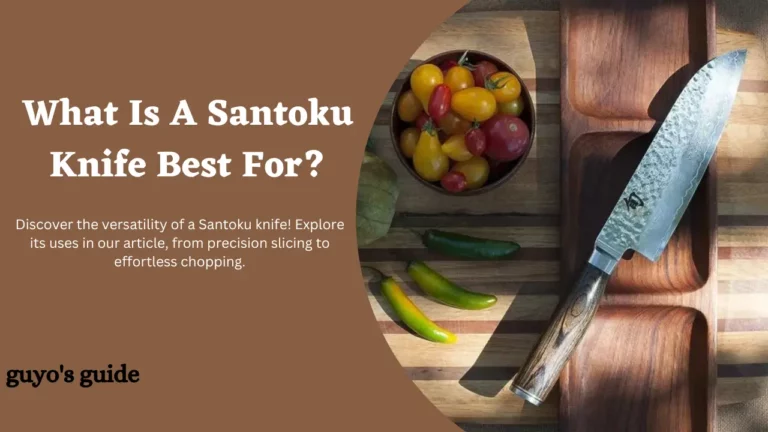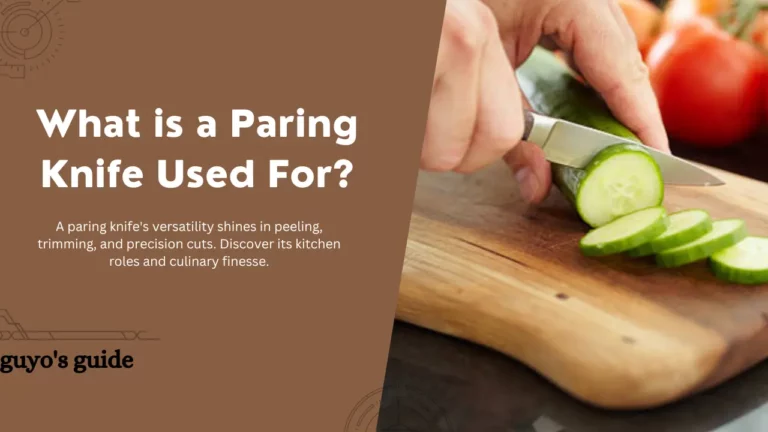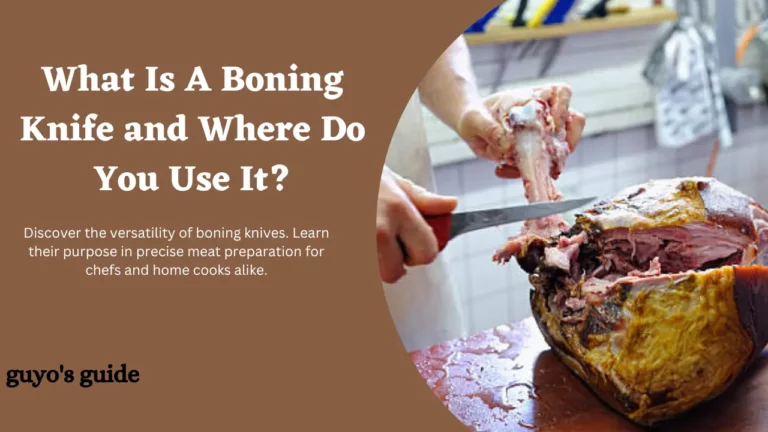Boning Knife vs. Fillet Knife (Expert Comparison)

Some of the links in this post are affiliate links, meaning, at no additional cost to you, We will earn a commission if you click through and make a purchase.
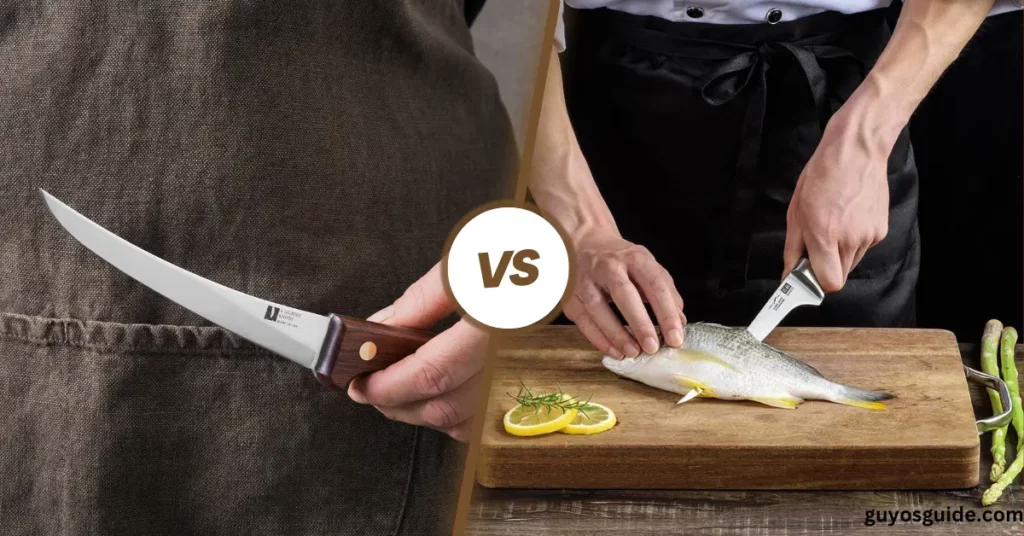
When it comes to working with meat or fish, having the right knife can make all the difference.
Two popular options for precision cuts are the boning knife and the fillet knife. While they may seem similar, these two knives have distinct features that cater to specific tasks.
Understanding the differences between them will help you choose the perfect tool for your culinary needs.
In this blog post, we will explore the characteristics of both the boning knife and the fillet knife, and discuss their unique advantages.
Let’s jump in.
Boning Knives
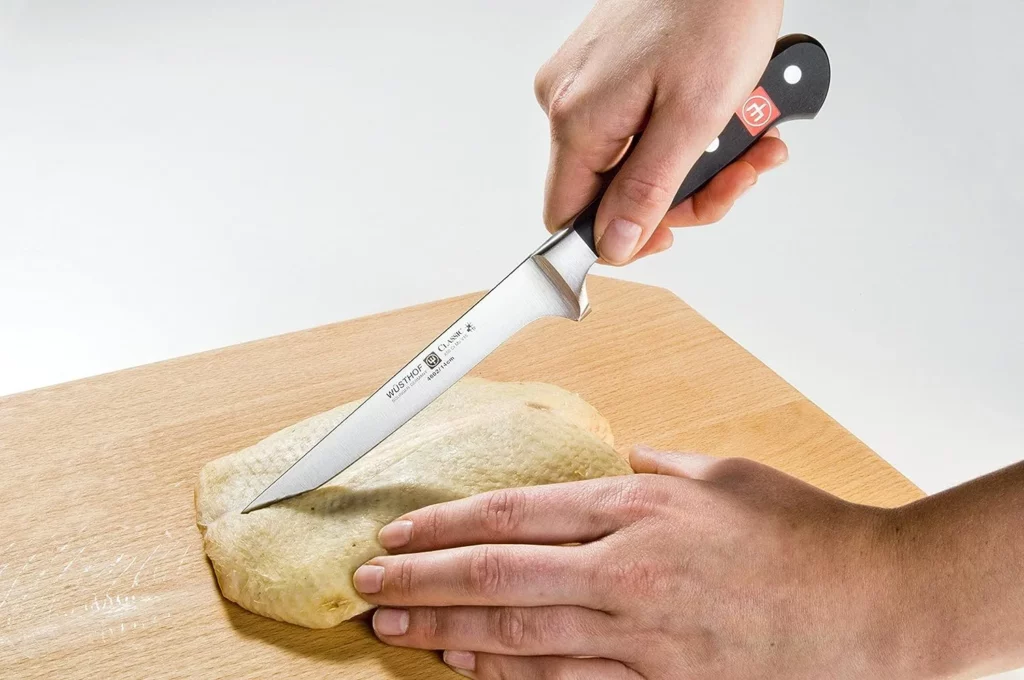
Boning knives are specialized kitchen knives designed for the precise and efficient removal of bones from meat, poultry, and fish.
Their primary purpose is to separate the meat from the bones, making them a crucial tool for butchers, chefs, and home cooks who frequently work with raw cuts of meat.
These knives are engineered to make clean and accurate cuts, ensuring minimal meat wastage.
Characteristics and Design of Boning Knives:
- Blade Shape: Boning knives typically have narrow, pointed blades that vary in length. The shape allows for precise control when navigating around bones and joints.
- Blade Flexibility: Boning knives come in different levels of flexibility, which can be categorized as stiff, semi-flexible, and flexible. The flexibility depends on the intended use, with stiffer blades being suitable for tougher cuts and more flexible blades for delicate work.
- Blade Material: High-quality boning knives are often made from stainless steel or high-carbon stainless steel, which provides sharpness, corrosion resistance, and durability.
- Handle: The handle design varies but is generally ergonomic and comfortable for extended use. Some may have textured or non-slip grips to enhance control.
- Tang: A full tang, where the blade extends through the handle, is common in quality boning knives, as it ensures strength and balance.
Types of Boning Knives Available in the Market:
- Flexible Boning Knife: These knives have a highly flexible blade, making them ideal for removing bones from poultry and fish, as well as more intricate tasks like deboning a tenderloin.
- Semi-Flexible Boning Knife: These offer a balance between flexibility and rigidity and are suitable for general meat boning tasks.
- Stiff Boning Knife: Stiff boning knives have a rigid blade, making them appropriate for tasks that require more force and precision, such as removing bones from larger cuts of meat.
- Filet Knife: Although not strictly a boning knife, filet knives are similar in function and are designed for filleting fish. They have flexible blade that adapts to the contours of the fish.
Advantages and Disadvantages of Using Boning Knives
Advantages:
- Precision: Boning knives offer precise control, allowing for clean and efficient removal of bones without excessive meat wastage.
- Versatility: They can be used on various types of meat, fish, and poultry, making them valuable tools in the kitchen.
- Reduced Safety Risk: Using the right boning knife reduces the risk of accidents associated with using inappropriate knives for boning tasks.
- Improved Yield: Boning knives help maximize the usable portion of meat, resulting in better yield from cuts of meat.
Disadvantages:
- Specialized Use: Boning knives are designed for specific tasks and may not be as versatile as other types of kitchen knives.
- Maintenance: Like all knives, boning knives require regular honing and sharpening to maintain their performance.
- Careful Handling: The sharp, pointed tip of boning knives can be hazardous if not handled with care, making them unsuitable for certain users or environments.
Fillet Knives
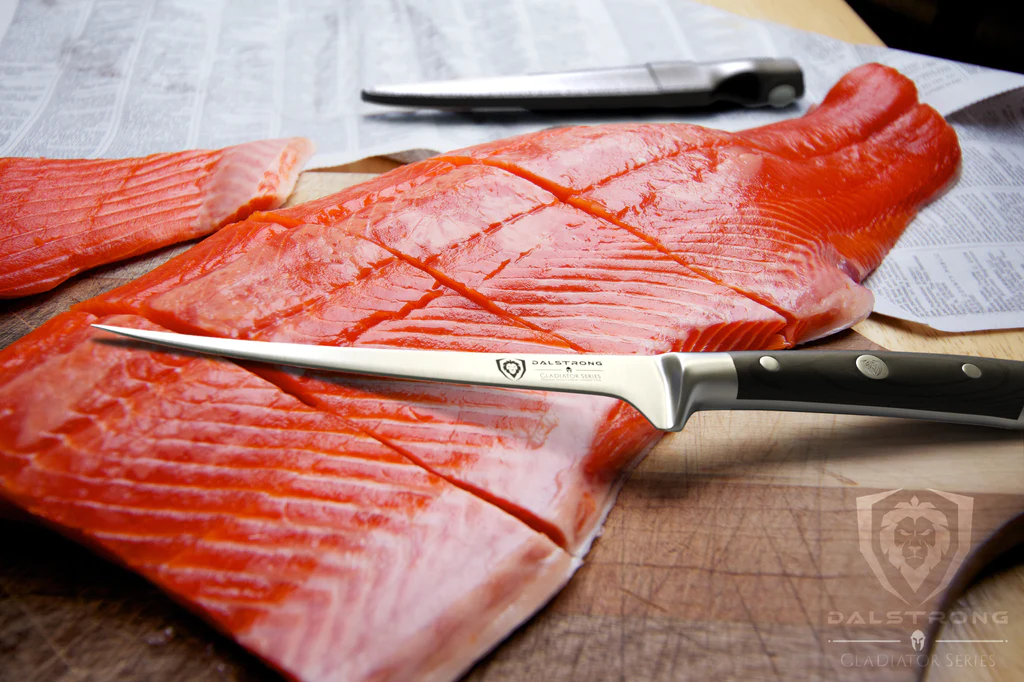
Fillet knives are specialized kitchen knives designed for the precise and delicate task of filleting fish.
Their primary purpose is to remove the bones and skin from fish while preserving as much meat as possible.
Fillet knives are essential for fishmongers, chefs, and home cooks who work with whole fish and want to create boneless fillets.
Characteristics and Design of Fillet Knives:
- Blade Shape: Fillet knives have a thin, flexible, and narrow blade that tapers to a sharp point. This shape allows for precise and intricate cuts along the contours of fish bones.
- Blade Flexibility: Fillet knives are known for their flexibility, which helps them adapt to the shape of the fish. This feature aids in removing skin and bones while minimizing waste.
- Blade Length: Fillet knives come in various lengths, typically ranging from 6 to 11 inches (15 to 28 cm). The choice of length depends on the size of the fish and the user’s preference.
- Blade Material: High-quality fillet knives are often made from stainless steel or high-carbon stainless steel to maintain sharpness, corrosion resistance, and durability.
- Handle: The handle design varies but is generally ergonomic and comfortable for precise and extended use. Non-slip or textured grips may enhance control.
- Tang: Many fillet knives feature a full tang design, where the blade extends through the handle, providing strength and balance.
Types of Fillet Knives Available in the Market:
- Fixed Blade Fillet Knife: These knives have a single, fixed blade and are known for their stability. They are often preferred by professionals.
- Electric Fillet Knife: Electric fillet knives are motorized and feature interchangeable blades. They are useful for high-volume filleting tasks and are popular among fishermen.
- Short Fillet Knife: These are typically 6 inches or less in length and are suitable for small to medium-sized fish.
- Long Fillet Knife: Longer fillet knives, often 9 inches or more, are ideal for larger fish or filleting multiple fish in one go.
Advantages and Disadvantages of Using Fillet Knives
Advantages:
- Precision: Fillet knives are specifically designed for precise filleting, resulting in minimal waste and beautifully filleted fish.
- Adaptability: The flexibility of the blade allows the knife to adapt to the contours of the fish, making it versatile for various fish species and sizes.
- Improved Yield: Fillet knives help maximize the usable portion of fish, providing better value from each fish.
- Reduced Safety Risk: Using the right fillet knife reduces the risk of accidents associated with using inappropriate knives for filleting tasks.
Disadvantages:
- Specialized Use: Fillet knives are designed primarily for filleting fish and may not be as versatile for other kitchen tasks.
- Maintenance: Like all knives, fillet knives require regular honing and sharpening to maintain their performance.
- Careful Handling: The sharp, pointed tip of fillet knives can be hazardous if not handled with care, making them less suitable for certain users or environments.
Comparison between Boning Knives and Fillet Knives
| Aspect | Boning Knife | Fillet Knife |
|---|---|---|
| Blade Shape and Flexibility | Narrow, semi-flexible to stiff blade | Thin, highly flexible and narrow blade |
| Blade Length and Thickness | 5-7 inches, uniform thickness | Thin, highly flexible, and narrow blade |
| Specific Uses and Recommended Meat | Versatile for meats, poultry, and fish | Specialized for fish, particularly filleting |
| Handling and Maneuverability | Substantial, slightly heavier handle | Lightweight, ergonomic handle |
| Price Range and Availability | Affordable and widely available | Variable pricing, availability may vary |
FAQs
What is the primary difference between a boning knife and a fillet knife?
A boning knife is designed for removing bones from meat, while a fillet knife is primarily used for filleting fish and deboning.
Can I use a boning knife to fillet fish or vice versa?
You can use a boning knife for filleting in a pinch, but it’s not ideal. A fillet knife is specifically designed for this purpose, offering better control and precision.
Which knife is better for cutting meat off the bone?
A boning knife is better for cutting meat off the bone, as it has a stiffer blade that can handle tougher cuts and thicker bones.
What types of meat can I use a boning knife for?
A boning knife is versatile and can be used for poultry, beef, lamb, and pork. It’s suitable for removing bones, skin, and excess fat.
What types of fish can I fillet with a fillet knife?
Fillet knives are designed primarily for fish but can also be used for smaller game or poultry. They excel at removing bones and achieving precise cuts in delicate meats.
How do I choose between a boning knife and a fillet knife?
The choice depends on your specific needs. If you frequently work with different meats and need to debone, a boning knife is versatile. If you primarily fillet fish, a fillet knife is the better option.
Wrap Up
The choice between a boning knife and a fillet knife ultimately depends on your culinary needs.
Both knives are invaluable assets in the kitchen, each designed with distinct features tailored to specific tasks.
Whether you’re a home cook or a professional chef, having the right knife for the job can make a world of difference in the precision and ease of your food preparation.
So, consider your preferred cuts and meats, and equip your kitchen accordingly to elevate your culinary adventures

